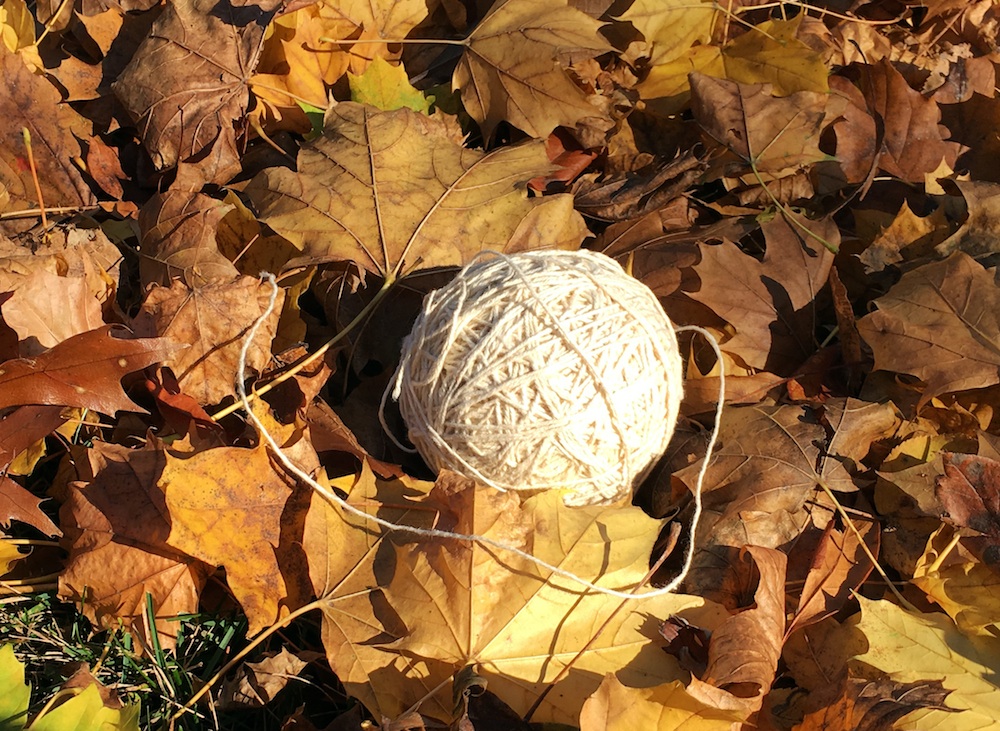
The ball of string fits reassuringly in my hand, smaller than a softball but just bigger than a baseball. Its perfect sphericity seems impossible against my palm, testament to the care and diligence with which it was wound.
For a long time after I brought it home from my grandmother’s kitchen, where it had been stored in a coffee can in a low cupboard drawer, the orb sat as a kind of museum piece on a bookshelf in my house. The string itself is aged, not quite yellow but certainly not white, smoother than one might expect, and tied together in pieces of about two feet with knots so secure that only magic could pry them apart. I have looked in every hardware store I pass for string of the exact diameter and strength and texture, without success.
In recent years I have begun to use the ball with college students in a class creativity activity that requires exactly one yard of string. Each time I cut three feet of string, I am struck that my grandmother would have added her final piece long before any of these students were born. Will I ever get to its center?
Do I want to?
Grandma Louise raised four children on a farm and ranch in Todd County, South Dakota, the third poorest county in the United States with a population density of six residents per square mile. My parents lived on the same farm, so I spent much of my early years at Grandma’s compact, white, two-story house, especially after the birth of my brother when I was two. He was colicky, my mother was depressed, and it was good for all involved for my chatty, impulsive self to be out from underfoot.
Tucked near the center of my being are long, delicious, formative hours watching Grandma roll dough for cinnamon rolls and wipe the flour from her hands onto her ever-present faded, calico apron that slipped over her head and tied loosely in a bow at the small of her back. From her I learned how to embroider dish towels and crochet potholders and iron men’s handkerchiefs. Together we listened to a radio program called Kitchen-Klatter, during which I would be shushed several times as I impatiently waited for it to end.
While rarely idle, she would have never described herself as “too busy.” She was a farmer’s wife, accustomed to waiting for bread dough to rise and cookies to bake, for crops to sprout, cattle to fatten, alfalfa to dry and wheat to ripen. For children and grandchildren to grow up.
A member of the “use it up, wear it out, make it do or do without” generation, Grandma repurposed long before repurposing was a thing (logophiles take note: the word “repurpose” was coined in 1984). The women of my youth never remodeled for the sake of remodeling nor bought anything new before the old was useless. Threadbare work shirts that could no longer protect from the sun willed their buttons to the button jar, their fabric to rags and quilts. Gravy turned any leftovers into feasts. Even dryer lint was transformed into stuffing for pincushions.
String was repurposed perhaps more than anything else. In an era before cellophane tape or plastic bags, grocers wrapped food in brown paper and string for its journey home. Parcels to be mailed were similarly packaged, as were holiday gifts. As I use my grandmother’s string one yard at a time, my appreciation swells for the simple and useful and for the cumulative significance of time. I imagine her unwrapping each package in her measured way, pulling the string taut to remove any kinks, knotting it expertly to the waiting naked end, then rewrapping the new addition tightly before returning it to the coffee can. Later she would cut new pieces to bind turkey legs or secure climbing bean plants to poles or show children how to play Cat’s Cradle or Jacob’s Ladder or telephone with tin cans. Then another package, another measure of string, and it all would start again.
In String Theory, everything—planets, trees, human beings, computers, energy—is ultimately the same at its core, a simple, one-dimensional, vibrating thread that unifies the universe. I cup my ball of string in my hands—hands that look with each passing year more and more like my grandmother’s, age spots and all—and the theory of everything slowly unfolds.
 Originally from rural South Dakota, Lisa Rivero lives in Milwaukee, Wisconsin, where she writes fiction and non-fiction, blogs for Psychology Today, changes water for her rapping betta fish (Marshall), stares out the window, reads in her comfy chair, and feeds the squirrels. She has published five books and, as a freelance indexer, has helped readers to find what they are looking for in hundreds of others. Connect with her at lisarivero.com and @lisa_rivero.
Originally from rural South Dakota, Lisa Rivero lives in Milwaukee, Wisconsin, where she writes fiction and non-fiction, blogs for Psychology Today, changes water for her rapping betta fish (Marshall), stares out the window, reads in her comfy chair, and feeds the squirrels. She has published five books and, as a freelance indexer, has helped readers to find what they are looking for in hundreds of others. Connect with her at lisarivero.com and @lisa_rivero.


2 comments for “String Theory by Lisa Rivero”